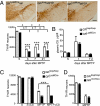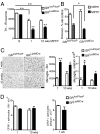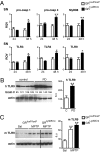Microglial glucocorticoid receptors play a pivotal role in regulating dopaminergic neurodegeneration in parkinsonism
- PMID: 21467220
- PMCID: PMC3080980
- DOI: 10.1073/pnas.1017820108
Microglial glucocorticoid receptors play a pivotal role in regulating dopaminergic neurodegeneration in parkinsonism
Abstract
Among the pathogenic processes contributing to dopaminergic neuron (DN) death in Parkinson disease (PD), evidence points to non-cell-autonomous mechanisms, particularly chronic inflammation mounted by activated microglia. Yet little is known about endogenous regulatory processes that determine microglial actions in pathological states. We examined the role of glucocorticoid receptors (GRs), activated by glucocorticoids released in response to stress and known to regulate inflammation, in DN survival. Overall GR level was decreased in substantia nigra of PD patients and 1-methyl-4-phenyl-1,2,3,6-tetrahydropyridine (MPTP)-intoxicated mice. GR changes, specifically in the microglia after MPTP treatment, revealed a rapid augmentation in the number of microglia displaying nuclear localization of GR. Mice with selective inactivation of the GR gene in macrophages/microglia (GR(LysMCre)) but not in DNs (GR(DATCre)) showed increased loss of DNs after MPTP intoxication. This DN loss in GR(LysMCre) mice was not prevented by corticosterone treatment, in contrast to the protection observed in control littermates. Moreover, absence of microglial GRs augmented microglial reactivity and led to their persistent activation. Analysis of inflammatory genes revealed an up-regulation of Toll-like receptors (TLRs) by MPTP treatment, particularly TLR9, the level of which was high in postmortem parkinsonian brains. The regulatory control of GR was reflected by higher expression of proinflammatory genes (e.g., TNF-α) with a concomitant decrease in anti-inflammatory genes (e.g., IL-1R2) in GR(LysMCre) mice. Indeed, in GR(LysMCre) mice, alterations in phosphorylated NF-κB levels indicated its protracted activation. Together, our data indicate that GR is important in curtailing microglial reactivity, and its deregulation in PD could lead to sustained inflammation-mediated DN injury.
Conflict of interest statement
The authors declare no conflict of interest.
Figures




References
-
- Dauer W, Przedborski S. Parkinson's disease: Mechanisms and models. Neuron. 2003;39:889–909. - PubMed
-
- McGeer PL, Itagaki S, Akiyama H, McGeer EG. Rate of cell death in parkinsonism indicates active neuropathological process. Ann Neurol. 1988;24:574–576. - PubMed
-
- Kurkowska-Jastrzebska I, Wrońska A, Kohutnicka M, Członkowski A, Członkowska A. The inflammatory reaction following 1-methyl-4-phenyl-1,2,3, \6-tetrahydropyridine intoxication in mouse. Exp Neurol. 1999;156:50–61. - PubMed
-
- Ouchi Y, et al. Microglial activation and dopamine terminal loss in early Parkinson's disease. Ann Neurol. 2005;57:168–175. - PubMed
Publication types
MeSH terms
Substances
LinkOut - more resources
Full Text Sources
Medical
Molecular Biology Databases

